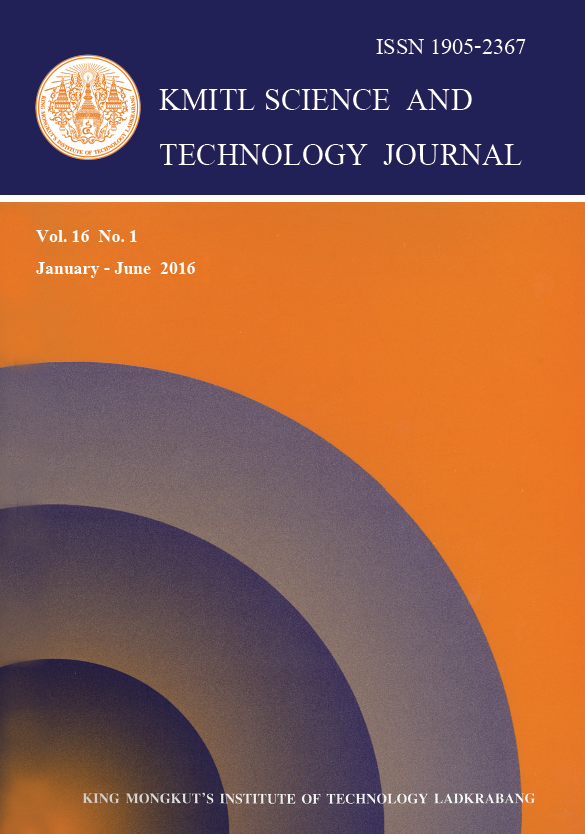Comparison of GPS Positioning Accuracy Using KlobucharModel and IGS TEC Model in Thailand
Main Article Content
Abstract
In global positioning system (GPS), ionospheric delay is a dominant source of errors causing degradation in positioning accuracy. To compensate for the ionospheric delay, Klobuchar model is a well-known model which is currently used for civilian single-frequency GPS receiver. The coefficients of the model are broadcast daily in the GPS satellite navigation message for worldwide users. However, its accuracy can be alternatively improved by the total electron content (TEC) data provided by the International GNSS Service (IGS).In this work, we compare the ionospheric delays from the Klobuchar model with the TEC IGS modelat Chiang Mai, KMITL and SuratThani stations in Thailand during 2014.The results show that the maximum difference of about 6.25 meters occurs at Chiang Mai station. We then compare the receiver positioning errors when these two ionospheric delay compensations are applied at various seasons. The results show that the IGS TEC compensation gives more improvement than the Klobuchar compensation. The maximum percentage reduction of 95% error is 42.311% with IGS TEC compensation. The accuracy in June and December solstice is lower than March and September equinox. The positioning errors at the low-latitude stationarefound to be lower than the high-latitude station.
Keywords: Positioning accuracy, Ionospheric delay, Global positioning system
*Corresponding author: Tel.: +66 837709531
E-mail: 57601153@kmitl.ac.th (S. Jongsintawee)
Article Details
Copyright Transfer Statement
The copyright of this article is transferred to Current Applied Science and Technology journal with effect if and when the article is accepted for publication. The copyright transfer covers the exclusive right to reproduce and distribute the article, including reprints, translations, photographic reproductions, electronic form (offline, online) or any other reproductions of similar nature.
The author warrants that this contribution is original and that he/she has full power to make this grant. The author signs for and accepts responsibility for releasing this material on behalf of any and all co-authors.
Here is the link for download: Copyright transfer form.pdf
References
[2] He,Y. and Bilgic, A., 2011. Iterative least squares method for global positioning system. Adv. Radio Sci., 9, 203-208.
[3] Mosavi, M.R., Azarshahi, S., Emamgholipour, I. and Abedi, A.A., 2014.Least squares techniques for GPS receivers positioning filter using pseudo-range and carrier phase measurements.Iranian Journal of Electrical & Electronic Engineering, 10(1).
[4] Kintner, P.M. and Ledvina, B.M., 2005. The Ionosphere, Radio navigation, Global Navigation Satellite Systems. Advance in Space Research, vol. 35,pp. 788-811.
[5] Shrestha, S.M., 2003. Investigations into the Estimation of Tropospheric Delay and Wet Refractivity Using GPS Measurement.Department of Geomatics Engineering, Canada.
[6] International GNSS Service, 2003. IGS Products. [Online] Available at: https://igscb.jpl.nasa.gov/components /prods.html.
[7] Najman, P. and Kos, T., 2014. Performance Analysis of Empirical Ionosphere Models by Comparison with CODE Vertical TEC Maps. [Online] Available at: https://www.intechopen.com/books/howtoreference/mitigation-of-ionospheric-threats-to-gnss-an-appraisal-of-the-scientific-and-technological-outputs-of-the-transmit project/performance-analysis-of-empirical-ionosphere-models-by-comparison-with-code-vertical-tec-maps.
[8] Li, J.and Ma, G., 2014. Variation of single-frequency GPS positioning errors at Taiwan based on Klobuchar Ionosphere Model. General Assembly and Scientific Symposium (URSI GASS), pp. 1-4. Beijing.
[9] Klobuchar, J.A., 1987. Ionospheric time-delay algorithms for single-frequency GPS users.IEEE Transactions on Aerospace and Electronic System (3), 325-331.
[10] Hada, T. and Tanaka, T., 2004. Study on Ionospheric Delay in GPS Standard Positioning Service. SICE Annual Conference,volume 1, pp. 226-229, Sapporo.
[11] Subirana, J.S., Juan Zornoza, J.M. and Hernandez-Pajares, M., 2011. KlobucharIonosphericmodel. Technical University of catalonia, Spain.
[12] Swamy, K.C.T., Sarma, A.D., Srinivas, V.S., Kumar, P.N., SomasekharRao, P.V.D., 2013. Accuracy evaluation of estimated ionospheric delay of GPS signals based on Klobuchar and IRI-2007 models in low latitude region. IEEE Geoscience and Remote Sensing Letters, 10(6), 1557-1561.
[13] Suwantragul, S., Rakariyatham, P., Komolmis, T., Sang-In, A., 2003. A modelling of ionospheric delay over Chiang Mai province.ISCAS '03.Proceedings of the 2003 International Symposium on Circuits and Systems,25-28 May 2003, Bangkok, Thailand.
[14] Macalalad, E.P., 2014. Application of a GPS Radio Occultation Based Ionospheric Model to Single-Frequency Code-Based Stand-Alone and Differential GPS Positioning, National Central University. China.
[15] Dutt, V.B.S. and Gowsuddin, S., 2013. Ionospheric Delay Estimation Using Klobuchar Algorithm for Single Frequency GPS Receivers.International Journal of Advance Research in Electronics and Communication Engineering (IJARECE), 2(2), 203-207.


